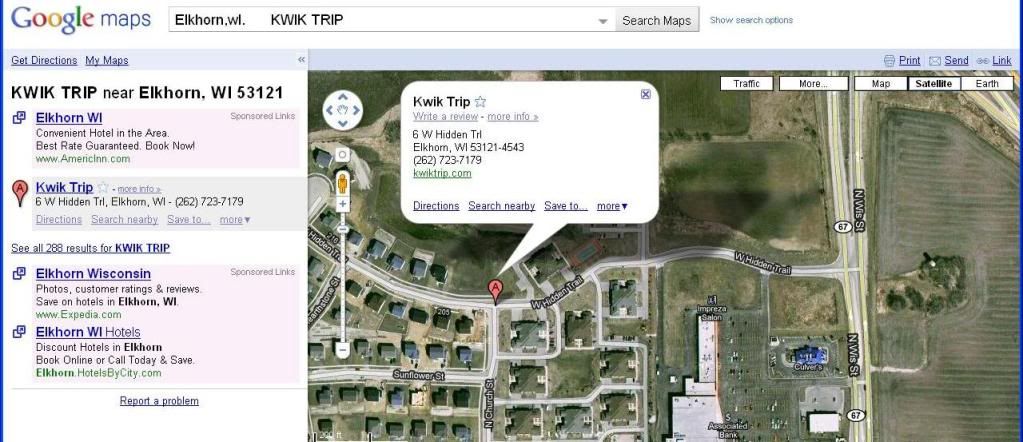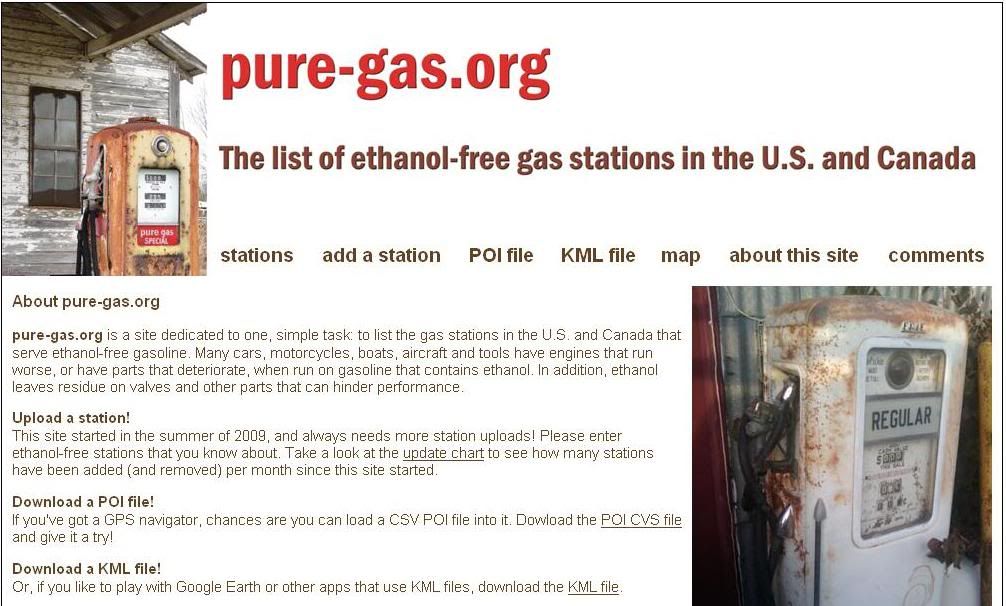 Pure-gas.org
Pure-gas.org is a site dedicated to one, simple task: to list the gas stations in the U.S. and Canada that serve ethanol-free gasoline. Many cars, motorcycles, boats, aircraft and tools have engines that run worse, or have parts that deteriorate, when run on gasoline that contains ethanol. In addition, ethanol leaves residue on valves and other parts that can hinder performance.
http://pure-gas.org/about
=============================
Origin of the 'Higher Octane is Better' Concept
Higher octane gasoline did reduce engine knock in older engines that used carburetors to regulate the air/gas mix. The older engines could not regulate the air/fuel mix going into the engine as efficiently as a computerized fuel injector. A carburetor in need of adjustment could cause too much fuel to be mixed with the air, which meant the gasoline would not burn completely. The excess gas soaked into carbon deposits and caused a premature ignition of the gasoline from the heat of the engine cylinder. The premature ignition made a sound that came to be known as 'engine knock.' When this happened, people would change to the higher octane/slower burning gasoline to resist the premature burn, thus minimizing the knock. Upping the octane was beneficial then, but engines and gasoline formulations changed.
Since the mid-1980s engines use fuel injectors with computers to accurately control the air/fuel mix over all temperature and environment ranges. The accuracy of the fuel injectors and computers is based on using the recommended gasoline for that engine. Most cars are designed to burn regular unleaded gas with an octane rating of 87. If the vehicle needs a higher octane rating this requirement is noted in the owner's manual and usually under the fuel gauge and by the gas tank.
Gasoline Factors That Matter
The quality of gasoline and the additive package usually affect the rate of engine wear more than the octane rating. Basically what this means is that it matters more where you buy your gas than which grade you purchase.
Regular Unleaded Gasoline
The recommended gasoline for most cars is regular 87 octane. One common misconception is that higher octane gasoline contains more cleaning additives than lower octane gas. All octane grades of all brands of gasoline contain engine cleaning detergent additives to protect against engine deposit build-up. In fact, using a gasoline with too high of an octane rating may cause damage to the emissions system.
? Gasoline and Octane Ratings - This article defines octane ratings and provides an overview of how gasoline in made.
Mid-Grade Gasoline
The octane ratings 'regular', 'mid-grade', and 'premium' are not consistent. In the United States, for example, one state may require a minimum octane rating of 92 for premium gasoline, while another may allow an octane rating of 90 to be premium. Check the octane rating on the yellow sticker on the gas pump rather than relying on descriptive labels.
Premium Gasoline
Certain high performance engines benefit from use of high octane fuel. For other engines, using a fuel with a higher octane rating than the vehicle requires sends unburned fuel into the emissions system and catalytic converter. This puts unecessary stress on the emissions system. For some vehicles, a rotten egg smell coming from the tailpipe signals use of too-high octane gas.
Leaded Gasoline
Many countries continue to use leaded gasoline, even though lead exposure has significant health and environmental consequences and the cost of switching to unleaded gasoline is relatively low. Although greatly improved, research indicates significant health and environmental effects from use of leaded gasoline remain even in countries that have switched to unleaded fuel.
Synthetic and Reformulated Fuels
Some major cities with air pollution problems require the use of reformulated gasoline. Reformulated gasoline is an oxygenated fuel that burns cleanly but can lower fuel economy and engine performance slightly. Reformulated gasoline may cause pinging or premature burn in engines with excessive carbon deposits. Older/dirtier engines may benefit from stepping up to the next grade of gasoline.
======================
Ethanol (ethyl alcohol) is an alternative fuel fermented from corn, grains or agricultural waste or it is chemically extracted from ethylene (hydration). It is used primarily as a supplement to gasoline.
Pure ethanol is not sold as a stand-alone fuel, at least not yet?it is commonly mixed with gasoline in varying percentages creating a transitional fuel that will pave the way for pure alcohol vehicles. For example, E85 is a common mixture: 85 percent ethanol, 15 percent gasoline. Most pump gasoline contains ethanol in much lower percentages. In the United States, it is added to gasoline in varying quantities (most commonly 10 percent) to boost the octane level and meet EPA requirements for oxygenated (smog reducing) fuels, especially in metropolitan areas.
To burn high concentrations such as E85, vehicles have to be designed as flex-fuel vehicles (FFVs) to utilize the unique combustion characteristics and tolerate the corrosiveness of the alcohol.
Pros: A Yes Vote
* Clean burning fuel: Reduces ozone-forming emissions.
* Renewable: It?s plant based, therefore what is used can be re-grown.
* Support of local agriculture: Produced domestically, it?s one more way to support local farmers.
Cons: What to be Aware of
* Corrosive: Tends to deteriorate non-synthetic and natural rubber fuel system parts.
* Land and labor viability: Large amounts of farmland and labor are required to grow the crops.
* Lower energy content than gasoline: Gasoline contains about 114,000 BTUs per gallon versus ethanol's 76,000 BTUs per gallon. This equates into reduced fuel mileage depending upon the fuel mixture percentage.
Handling & Safety
Since ethanol is less volatile than gasoline, there?s a reduced chance of explosion in spills and accidents. Although it is more corrosive than gasoline, it is less toxic.
Potential
The future looks good for ethanol. Not only are many ethanol refineries in the planning stages or under construction, ethanol blends (E85, E10) are becoming easier to obtain. Plus, it's fairly simple to implement into your life: With a flex-fuel vehicle and a local fueling station, you can just fill up and drive away.
======================
Octane Rating
From Wikipedia, the free encyclopedia
The octane rating is a measure of the resistance of petrol and other fuels to auto ignition in spark-ignition internal combustion engines.
>>>
http://en.wikipedia.org/wiki/Octane_rating
======================
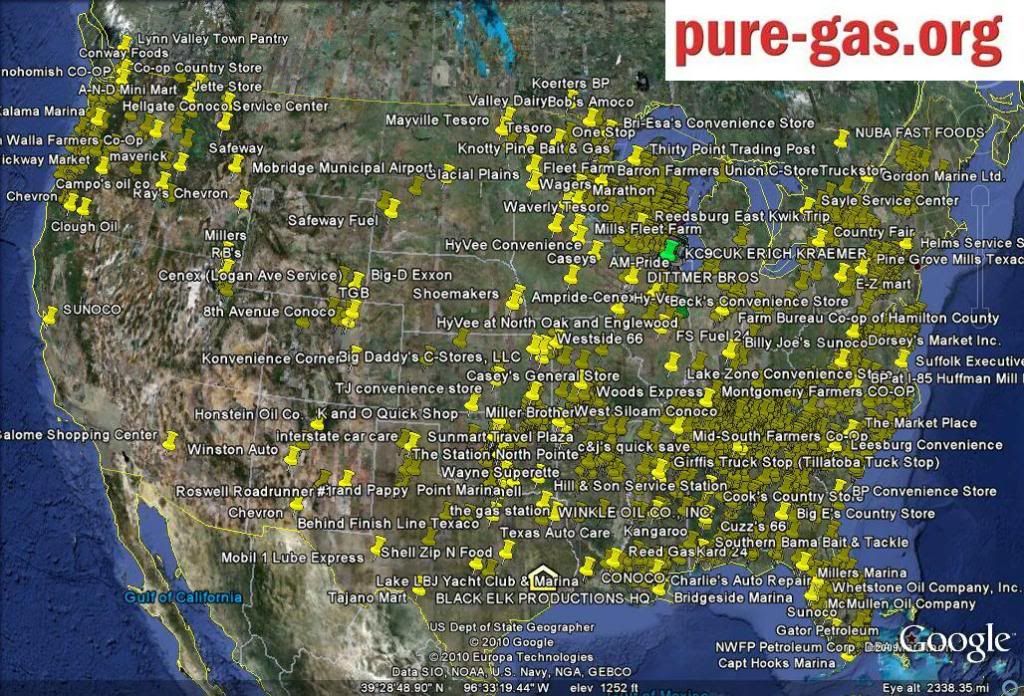
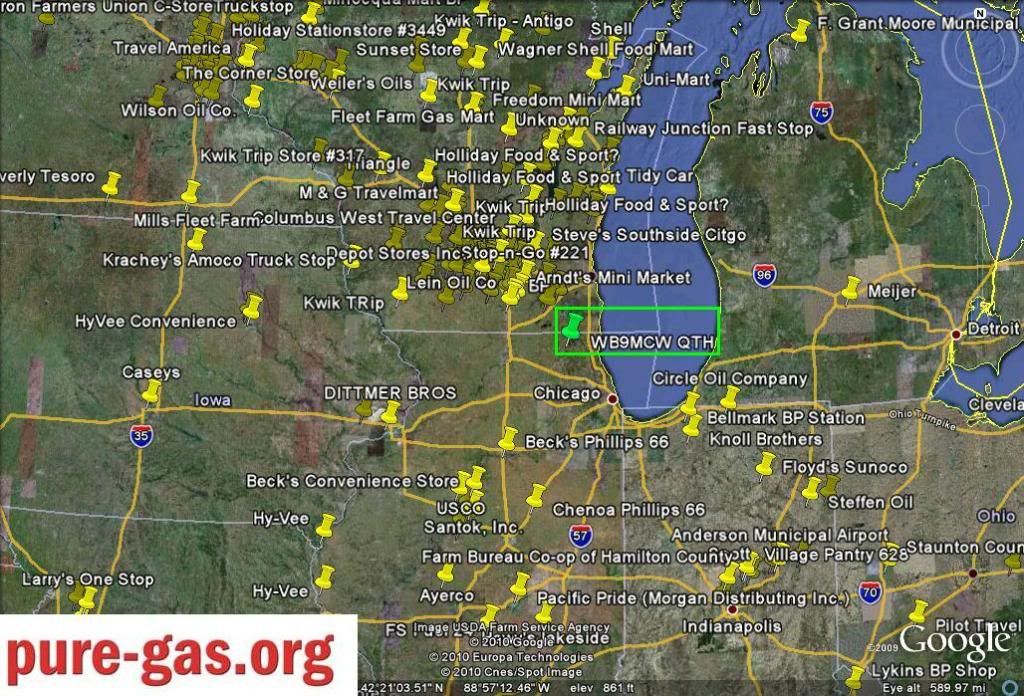
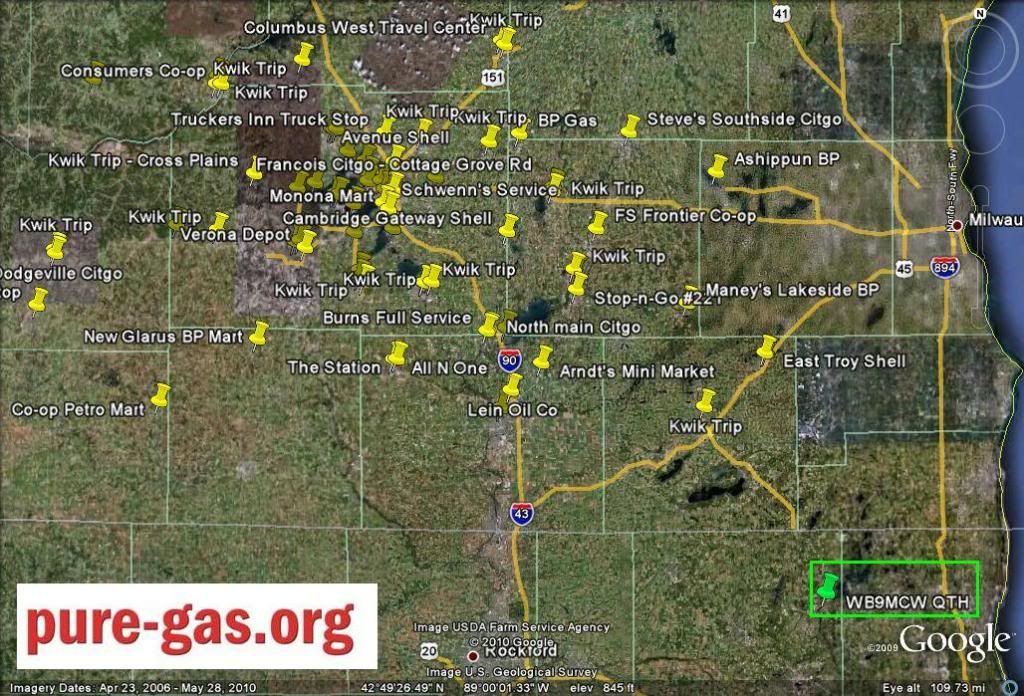 I CALLED THE KWIK TRIP IN ELKHORN, WI. AND THEY
I CALLED THE KWIK TRIP IN ELKHORN, WI. AND THEY
DID ACTUALLY HAVE 91 GRADE PURE GAS FOR $3.05 A GALLON
